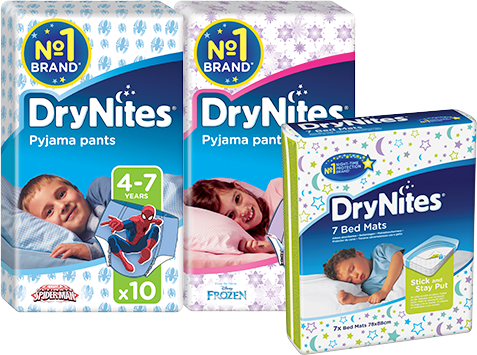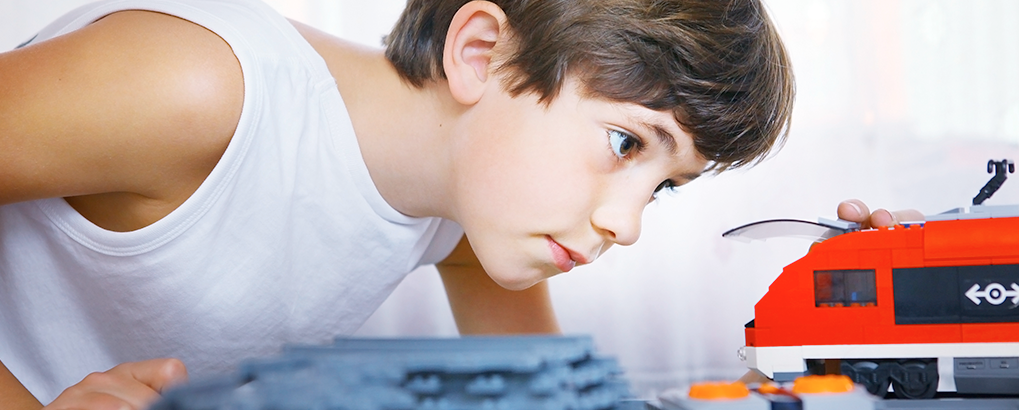General
How does wearing DryNites® Pyjama Pants help?
DryNites® Pyjama Pants not only help children who wet the bed get a good night’s sleep, they help them maintain a sense of privacy and boost their confidence. They make managing bedwetting easier for you as well, by minimising night time disruptions and wet sheets.
What sizes do DryNites® Pyjama Pants come in?
DryNites® Pyjama Pants are available in three sizes:
3-5 years, (for Boys and Girls)
4-7 years, (for Boys and Girls)
8-15 years, (for Boys and Girls)
See the complete DryNites product range here
What’s the difference between nappies, nappy pants, Pull-ups and DryNites?
Nappies and nappy pants offer similar levels of absorbency. Nappy pants are designed to allow change without having to lie down. Pull-Ups are designed for potty training: they have specific features like a learning liner that lets kids feel a brief sensation of wetness– an important indicator when potty training. Finally, DryNites are for children who already dry during the day, but wet the bed at night. They are more absorbent and discreet, something that’s especially important for older children
Should my child wear underwear with DryNites® Pyjama Pants?
Most children wear DryNites® Pyjama Pants as a replacement for underwear at night. However, underwear certainly can be worn over their DryNites® Pyjama Pants for more discretion.
What is bedwetting?
Bedwetting is urinating at night time during sleep. It’s a developmental stage that kids have no control over and most will become dry in their own time.
Is bedwetting caused by ‘poor’ toilet training?
No. Bedwetting is not something your child has any control over, and there’s no evidence that daytime toilet training has any influence on bedwetting.
I carry my sleeping child to the toilet during the night. Does this help?
This method, commonly referred to as ‘lifting’. Most parents try ‘lifting’ at some point, as taking them to the toilet seems like an obvious way to stop, or at least control, the bedwetting. What it actually does is reinforce to the child that they can urinate while they are asleep. This can make the wetting worse as the child is weeing without responding to their brain waking them because of a full bladder.
How can I stop my bedwetting child’s siblings from teasing them?
Tell them that bedwetting is perfectly common, that it’s a stage many children go through, and that their sibling has no control over while they’re asleep. Explain how it can run in the family, and that their parents might have experienced it to. Help them empathise by asking them how they would have felt if they were the one wetting the bed, and were being teased about it. You can also make a rule of no teasing, which, like other rules, has consequences if broken – such as no treats the next day or no TV.
Are boys more likely to wet the bed than girls?
Yes. Boys are more likely to experience bedwetting than girls, particularly in the younger age groups.
Do boys wet the bed because they’re naughty or lazy?
Bedwetting boys are not in control of their situation. They don’t do it on purpose to annoy parents or because they don’t want to wake up to go to the toilet. They are asleep when it happens. Most boys can’t wait to be dry at night. Telling him off and/or getting angry will only make them scared and anxious, which can make bedwetting last longer.
Does wearing DryNites® Pyjama Pants stop my boy from becoming dry at night? People say that if he feels the wetness he might stop wetting the bed.
This is a very common question, and one of the more widely believed bedwetting myths. There is no evidence that this is the case. DryNites® Pyjama Pants don’t cure bedwetting, but they help you to manage it and ensure that both you and your son have a good night’s sleep.
Our Pyjama Pants are here to help you manage bedwetting
- take a closer look


